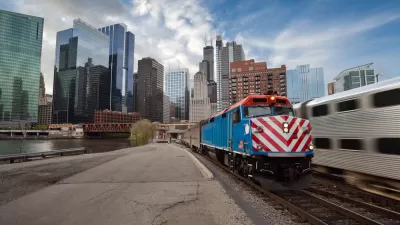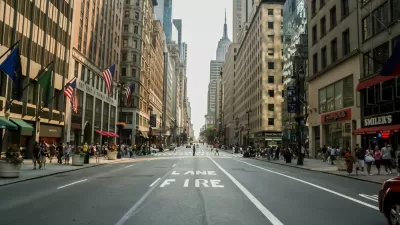A report from the Long Island Index explores the economic impact of a new Third Track on the Long Island Rail Road.
The Long Island Index, a project of the Rauch Foundation, released a report on the economic benefits of the proposed Third Track – also called the "Fast Track" – on the Main Line of the Long Island Rail Road (LIRR). The report, titled "The Economic and Fiscal Impacts of the Long Island Rail Road Main Line Third Track," analyzes the projected economic impact of adding an additional track to a 9.8-mile segment of the LIRR Main Line to determine the value to the region of opening the bottleneck that is currently restricting rail traffic and limiting opportunities for reverse-commuting.
Job growth on Long Island has been sluggish for two decades, and a primary obstacle to growth is the lack of capacity for reverse-commuting on the Long Island Rail Road. Regular commuting (into New York City in the morning and back home in the evening) has been a major economic driver on Long Island for generations, contributing $26 Billion in personal income to Long Island’s economy in 2011 alone. Reverse-commuting (as well as regular commuting), however, is expanding the economic opportunities for Northern New Jersey, Westchester, and Southern Connecticut, but not Long Island.
The proposed Third Track – or "Fast Track" – and its 9.8 miles would achieve the following:
- Improve reliability throughout the entire LIRR network.
- Allow significant levels of reverse peak and intra-Island service to Main Line stations, while increasing capacity for the Port Jefferson Branch, Montauk Branch, Ronkonkoma Branch, and Oyster Bay Branch.
- Achieve the full benefits of East Side Access.
- Expand and improve the Long Island workforce by providing a viable reverse-commute service, while also enhancing opportunities for transit-oriented development (TOD), creating live/work settings that meet the needs of new-economy firms and workers.
Based on the higher level of service enabled by the Third Track, including the facilitation of transit-oriented developments in station areas, the report projects the following net new economic and fiscal impacts of the construction and operation of the Third Track – meaning that, but for the existence of the Third Track, these impacts would not have occurred on Long Island.
- One-time construction impacts
Construction of the Third Track would represent a $1.2 Billion investment in the Long Island economy over a five-year period. The investment would result in:
- 2,250 Average Annual Jobs;
- $910 Million in Cumulative Personal Income;
- $910 Million in Cumulative Gross Regional Product.
- Ongoing impacts
The economic impacts of the Third Track’s operations would begin to accrue in 2025, when the track is assumed to be operational. The total ongoing benefits of the Third Track for Long Island derive from improved workforce access and better LIRR service. The Third Track would effectively increase the workforce available to Long Island businesses by making reverse-commuting viable. Travel time savings and increased ridership would stimulate Long Island’s economy by improving quality of life, reducing business costs, and promoting spending. The availability of more frequent reverse-commuter trains would attract more tourist dollars to Long Island.
The analysis assumed that six station areas in Nassau County and four in Suffolk County could accommodate transit-oriented development, facilitating additional economic growth by locating more residents and workers precisely where they can most benefit from increased service. The increased density of employment on Long Island encouraged by transit-oriented development would enhance the productivity of Long Island firms.
By 2035, 10 years after the Third Track’s completion, the impacts would be:
- 14,000 new jobs;
- $5.6 Billion in additional Gross Regional Product (GRP);
- $3.0 Billion in additional personal income;
- 35,400 new residents to Long Island, of whom 39% would be in the 25-to-44-year-old age cohort, compared to only 20% of Long Island’s total forecasted 2035 population without the Third Track.
Additionally, the Third Track would generate $40 million in annual sales tax revenue and $103 million in annual property tax revenue as of 2035.
The long-term benefits derived from the Third Track investment would generate a significant payoff for Long Island. In present-value terms, an investment of $1.1 Billion produces cumulative benefits of:
- $7.7 Billion GRP + 4,000 Jobs by 2030;
- $36.3 Billion GRP + 20,000 Jobs by 2040;
- $67.9 Billion GRP + 25,000 Jobs by 2050.
"The Fast Track’s positive growth potential for Long Island is enormous," said Nancy Rauch Douzinas, President of the Rauch Foundation. "There is no other single project on the drawing boards that has the potential to increase Long Island’s economy more than this."
Kevin Law, President and CEO of the Long Island Association and Co-Vice Chair of the Long Island Regional Economic Development Council, said: "The study commissioned by the Long Island Index provides further evidence that the Third Track project could be a game changer for our region by improving reliability for commuters, adding new jobs and facilitating economic growth and more transit-oriented development."
"The Third Track will enable Long Island to attract and retain the jobs that our young people seek," said Dr. Thomas Rogers, District Superintendent & CEO of Nassau BOCES. "We need to invest in our children’s futures the way our parents invested in ours."
FULL STORY: LIRR's Third Track Job Could Add Billions to Long Island Economy, Report Says

Pennsylvania Mall Conversion Bill Passes House
If passed, the bill would promote the adaptive reuse of defunct commercial buildings.

Coming Soon to Ohio: The Largest Agrivoltaic Farm in the US
The ambitious 6,000-acre project will combine an 800-watt solar farm with crop and livestock production.

World's Largest Wildlife Overpass In the Works in Los Angeles County
Caltrans will soon close half of the 101 Freeway in order to continue construction of the Wallis Annenberg Wildlife Crossing near Agoura Hills in Los Angeles County.

California Grid Runs on 100% Renewable Energy for Over 9 Hours
The state’s energy grid was entirely powered by clean energy for some portion of the day on 37 out of the last 45 days.

New Forecasting Tool Aims to Reduce Heat-Related Deaths
Two federal agencies launched a new, easy-to-use, color-coded heat warning system that combines meteorological and medical risk factors.

AI Traffic Management Comes to Dallas-Fort Worth
Several Texas cities are using an AI-powered platform called NoTraffic to help manage traffic signals to increase safety and improve traffic flow.
City of Costa Mesa
Licking County
Barrett Planning Group LLC
HUD's Office of Policy Development and Research
Mpact Transit + Community
HUD's Office of Policy Development and Research
Tufts University, Department of Urban and Environmental Policy & Planning
City of Universal City TX
ULI Northwest Arkansas
Urban Design for Planners 1: Software Tools
This six-course series explores essential urban design concepts using open source software and equips planners with the tools they need to participate fully in the urban design process.
Planning for Universal Design
Learn the tools for implementing Universal Design in planning regulations.

























